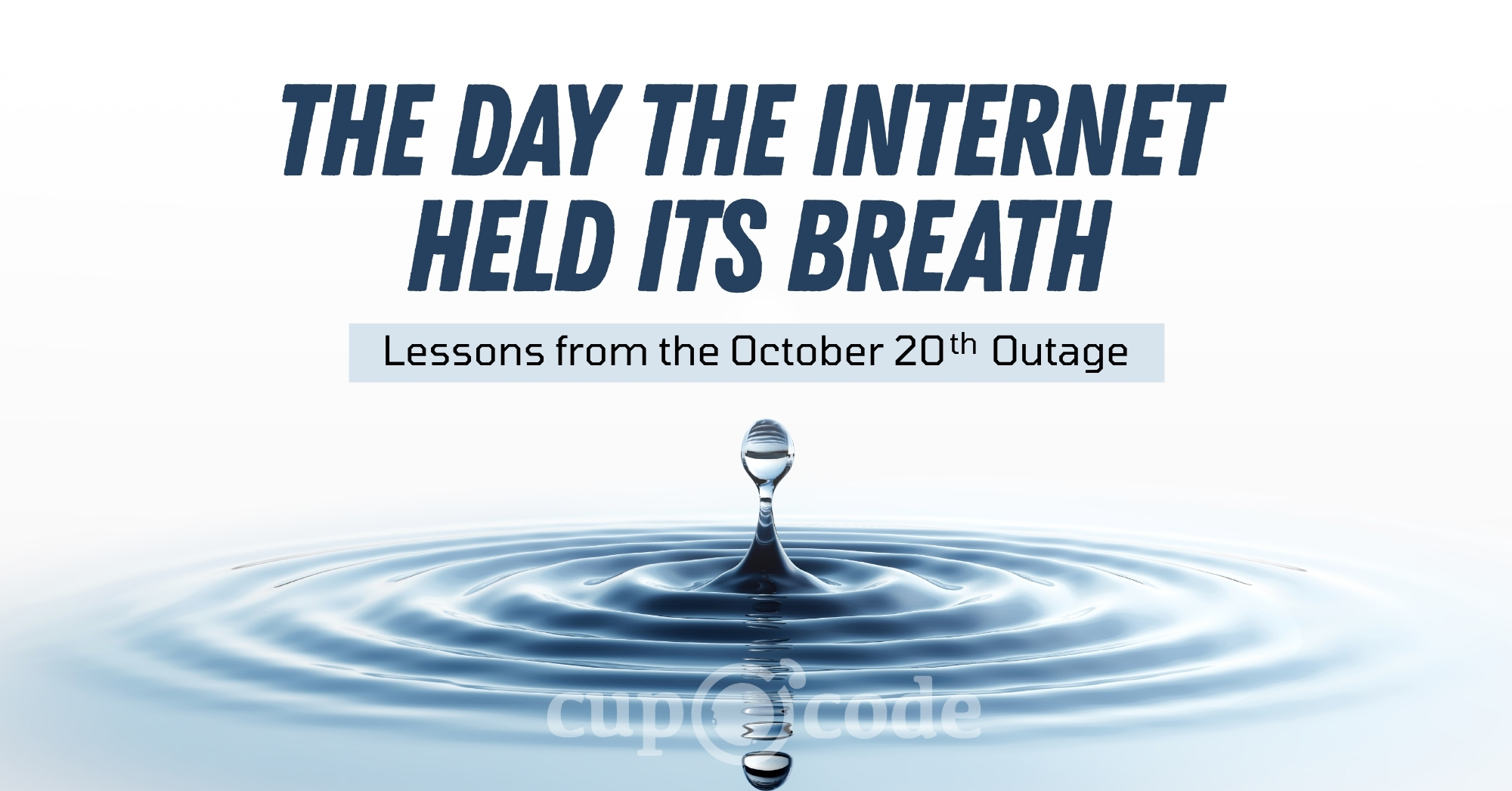Did you feel it on Monday, October 20th? That quiet, strange moment when the digital world seemed to hold its breath? It wasn’t just you. For several hours, with some services sputtering for nearly 15 hours, a significant portion of the Internet simply… stopped working1. Your favorite apps went silent, games wouldn’t load, student sites weren’t accessible and even your smart speaker sat quiet. It felt personal, like a problem with your own connection, but it was a global event that originated from a single, critical spot on the map. At Cup O Code, our first hint that something was off came when our cloud-based work management platform, Monday.com, began timing out—an early signal that this wasn’t a local hiccup but a broader issue.
This wasn’t a dramatic, movie-style attack. It was something far more subtle and, in some ways, more unsettling. A technical glitch deep within Amazon Web Services (AWS), the world’s largest cloud provider, rippled outward, touching nearly every corner of our connected lives2. It served as a powerful reminder of how interconnected, and fragile, our digital infrastructure truly is.
But this isn’t just a story about a technical failure. It’s a story about what happens when the systems we lean on stumble. It’s about understanding the invisible architecture that holds up our daily routines and, more importantly, what we can learn when it shows its snags. Let’s walk through what happened with the October 20th outage, why it mattered so much, and the hopeful, practical lessons we can take away from it.
What Really Happened?
On Monday, October 20th, 2025, the problem began in a massive data center hub known as US-EAST-1, located in Northern Virginia2. This isn’t just any data center; it’s one of the oldest and most important for AWS, and by extension, for a huge chunk of the Internet.
The root cause was traced back to a seemingly small but vital component: the Domain Name System (DNS) for a service called DynamoDB3. Think of DNS as the Internet’s phone book. It translates human-friendly web addresses (like amazon.com) into the numerical IP addresses that computers use to find each other. DynamoDB, in turn, is a core database service that thousands of applications use to store and retrieve critical data, from user profiles to game scores.
The issue was that the DNS “phone book” entry for the DynamoDB service in that region was reported as empty.
Applications trying to connect to their database were essentially told, “Sorry, that number doesn’t exist.” Without the ability to “find” the database, these applications couldn’t function, leading to a cascade of failures that spread with alarming speed.
Who Felt the Impact?
The ripple effect was widespread and felt across almost every sector. It wasn’t just a minor inconvenience; it was a global disruption that highlighted how many services we use daily that rely on the same foundational infrastructure.
The list of affected platforms reads like a “who’s who” of the Internet4:
- Social Media & Communication: Staying in touch became difficult as Snapchat, Reddit, WhatsApp, and Signal experienced major disruptions.
- Gaming & Entertainment: The digital playgrounds for millions went dark. Fortnite, Roblox, Clash of Clans, and the PlayStation Network all suffered outages. It impacted streaming services like Amazon Prime Video, Discord, and Twitch, too.
- Finance & Commerce: The outage hit people’s wallets. Financial apps like Venmo, and cryptocurrency exchanges such as Coinbase and Robinhood, reported issues. Even Amazon’s own e-commerce site, Amazon.com, and its smart devices like Alexa and Ring doorbells, had connectivity problems.
- Productivity & Utilities: The tools that power our work and daily lives weren’t spared. Canva, Duolingo, and Zoom saw service degradation. The impact extended to physical services, with US airlines like United and Delta, and even the UK’s tax service (HMRC), experiencing operational challenges2.
This wasn’t just a tech problem; it was a societal one. From paying a friend back for lunch to joining a work meeting, reading online class assignments or checking on your home security, the outage demonstrated how deeply these services weave into the fabric of our lives.
Why This Outage Matters
Many people shrug off an outage as soon as services return, but this event reveals a few critical lessons about the nature of our modern internet.
1. The Single Point of Failure Problem
The incident perfectly illustrates the risk of centralization. While the Internet was designed to be a decentralized network, a huge portion of it now runs on the infrastructure of just a few major cloud providers like AWS, Microsoft Azure, and Google Cloud3. When a core service at a dominant provider fails, the disruption is not isolated. It becomes a cascading global event. We’ve built an incredibly sophisticated digital world on a foundation that, in some places, is surprisingly narrow.
2. DNS: The Unsung Hero and Villain
The root cause—a DNS resolution issue—highlights that even seemingly minor pieces of infrastructure are mission-critical. DNS is the silent director of Internet traffic, and a failure there can paralyze the world’s most advanced cloud environments3. It’s a part of the system we rarely think about, but one that everything else depends on.
3. The Economic and Societal Cost
For businesses, hours of downtime translate directly into millions of dollars in lost productivity and revenue. But the impact goes beyond that. When essential services like banking, transportation, and government portals become affected, a technical glitch becomes a societal problem, raising serious questions about our collective digital resilience.
What We Can Do Now
It can feel a bit helpless to face an issue of this scale. After all, most of us don’t run a global cloud service. However, just like we prepare for power outages at home with flashlights and batteries, businesses and individuals can take small, meaningful steps to become more resilient when something like the October 20th outage happens again. The goal isn’t to become immune to failure—that’s impossible—but to be prepared for it.
Change can be scary, but it’s also where growth happens. This outage isn’t a reason to fear technology, but an invitation to understand it better and build smarter. It’s a chance to be brave and proactive.
Here are a few practical steps to consider:
- For Businesses: Understand Your Dependencies. Do you know which cloud provider hosts your website? What third-party services does your core software rely on? Simply making a list of these dependencies is a powerful first step. Understanding your own potential single points of failure is the start of any good resilience plan.
- Consider Redundancy. For critical applications, experts are renewing calls for multi-region or even multi-cloud strategies3. This means having a backup running in a different geographical location or with a different provider. While this adds complexity, the October 20th outage showed its value.
- Have a Communication Plan. When your services go down, how do you talk to your customers? Having a plan that doesn’t rely on the very services that might be down (like your website or email provider) is crucial. Think about a simple status page or a social media account you can use for updates.
A Hopeful Note on Building a Stronger Future
It’s easy to look at an event like the October 20th outage and see only fragility and risk. But there’s another way to see it. Every time a system is tested and fails, we learn something invaluable. These outages, as disruptive as they are, force us to adapt and innovate. They push us to build more robust, more resilient, and more intelligent systems.
This isn’t an ending. It’s a transformation. We are learning, in real-time, how to build a digital world that is as dependable as it is powerful. The path forward isn’t about avoiding setbacks, but about recognizing each moment our collective breath is held, and working until the systems we build allow us all to exhale—reassured, and ready to breathe easier the next time.












